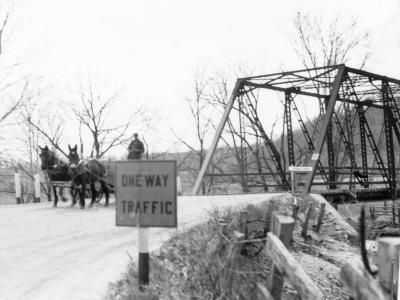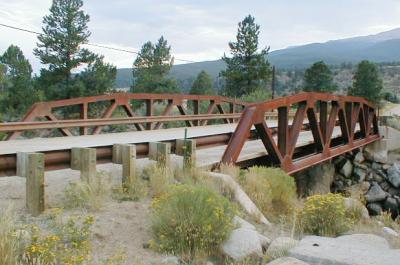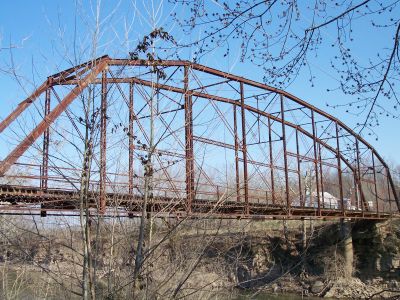About Bridgehunter.com
Maybe a line or two about who is writing this or when it was started?
What's the purpose of this site?
Much of today's historical research centers on genealogy, which seeks to answer questions about who. But all of this knowledge about ancestors and family trees and relationships tends to overlook other mportant questions. How did these people live? Where did they go? What was life like in those days? Have things changed since then -- or not?
It may seem silly, but this is where the study of historic bridges can prove useful. Some of these structures have stood unaltered for decades, just as our great-great-great-ancestors would have seen them. They may have been originally designed to carry horse-drawn wagons, but some are still capable of handling heavier automobiles today... if they receive proper maintenance and repairs.
 A horse-drawn wagon crosses a bridge in Arkansas in 1939 [Photo courtesy AHTD]
A horse-drawn wagon crosses a bridge in Arkansas in 1939 [Photo courtesy AHTD]Railroads have disappeared. Whole towns have vanished or relocated. Buildings have come and gone, or been remodeled beyond recognition. But bridges have remained intact, a silent reminder of our ancestor's way of life, and a tribute to skillful engineers who had no comprehension of modern school buses or SUVs -- and yet were able to build structure capable of standing the test of time.
But sadly, most people don't pay much attention to these historic monuments -- until they are gone. With Federal funding available for bridge replacements, county officials often aren't interested in rehabilitation or preservation. Why bother saving a rusting hulk when it can be replaced with a shiny new concrete span mostly paid by somebody else?
The problem, of course, is that the shiny new span will quickly turn into a downright boring eyesore that sticks out like a sore thumb against its surroundings. Nobody cares about a dull concrete bridge with monotonous guardrails and no charm whatsoever. Sure, these modern structures might be safer and stronger, but historic bridges can be brought up to current standards with proper care.
If an old railroad bridge could support a string of fully-loaded locomotives, then surely it can handle an SUV or two (unless it's in total disrepair). During their heyday, truss bridges represented the state-of-the-art for designs that were durable but yet affordable. We shouldn't bulldoze them just because they're old. Meanwhile, a well-built stone arch bridge is practically indestructible -- just look at the bridges in Rome that have carried traffic for over two millennia.
On the other hand, it's unrealistic to think that we can preserve every interesting bridge. Many old bridges are simply too deteriorated to worry about. Some are located at inconvenient places for future development. Some can't realistically carry modern traffic, no matter how much is spent on rehabilitation.
 Modern-day truss bridge in Colorado, built 1998
Modern-day truss bridge in Colorado, built 1998However, we should certainly save what we can. If it costs the same (or in some cases, less) to rehabilitate rather than replace, let's do it. If a bridge must be replaced, then let's try to give it some other use, such as a pedestrian crossing. And if all else fails, then we should certainly preserve it "on paper" with photographs and documentation.
The purpose of this site, then, is to assemble a database of the historic bridges in the Central United States. This includes everything from minor stone culverts to sweeping suspension bridges to massive steel truss spans. This also covers past, present, and future -- bridges that are long gone, those that are still standing, and those that might be built in the future using historic designs.
That last sentence is not a mistake. Even though truss bridges have fallen out of fashion, some companies still build them for roads and trails. These designs are not completely obsolete; the engineers of yesteryear knew things that we can still utilize today. Our new bridges don't always need to be ugly monstrosities -- heck, even covered bridges are making a small comeback.
One of the sayings in history is "the more things change, the more they stay the same." The study of historic bridges easily drives home that point.
How did this get started?
I've had many people say that they first become interested in bridges because they live (or grew up) near a particularly interesting one. While I've always had a budding fascination with civil engineering, this site didn't get started until I "discovered" the Wappapello Bridge in Wayne County, Missouri.
 Wappapello Bridge
Wappapello BridgeThis bridge sits very close to a tourist area, Lake Wappepllo, but is largely unknown. It's just off the main highway, but on a little-used side road. It's never mentioned in any tourist brochure. And yet this is one of the most magnificient bridges in Southeast Missouri.
Built in 1911, it has a single 210 foot clear span, large even by modern standards. Its Pennsylvania truss design was state-of-the-art at the time. And remarkably, the company that built it, Stupp Brothers, is still a family-owned business that builds steel bridges (among other things).
It also happens to be in poor condition and scheduled for replacement. But when I first stumbled across this bridge, I thought, "Wow, why doesn't anybody know about this?" I only found it because I was vaguely curious about where the road went and I had a few minutes to kill.
After other leisurely drives, I found more and more of these historic structures. And I also found a few that had been recently replaced, with perhaps an old pier or piece of discarded metal as the only remaining artifacts of their existence.
I knew: Somebody needs to document these things before they are lost. If some low-budget history museum can get mentioned in the tourist brochures, then why not a real historic site that is still being used? If people are willing to drive long distances to see a covered bridge, then why not a truss bridge? (It could be argued that a covered bridge is merely a truss bridge with a roof.)
As with most websites, this one started small, with photos of a few dozen bridges. But I quickly learned that I'm not the only one with a passion for history and civil engineering, and now this site features photos and information from dozens of contributors in several states. That's good; it means I'm not as weird as I thought...
How come you don't have such-and-such bridge listed?
Don't feel hurt if this site doesn't have your favorite bridges listed, it simply means I haven't reached your area yet. There's a lot of interesting bridges out there, and I have enough trouble keeping track of places in my own county, much less several states. (For that matter, I have enough trouble with simple things like, where the heck did I put my Arkansas atlas?)
If you send me photos or information, though, I'll happily try to post them as soon as possible. So if you see gaps in coverage, that's your invitation to help!
Do you have any words of wisdom for finding bridges?
No, but here's a few pointless observations I've made:
1. The farther you drive to reach a bridge, the more likely it has already been replaced.
2. The best place to photograph a bridge is often posted with signs like, "No Trespassing -- Violators Will Be Sold As Slaves" and "Warning: My Dog Can Outrun You".
3. When trying to find the turnoff for a bridge, some fool will always appear out of nowhere and start tailgating you. But even though they are in some massive hurry, they will never pass you -- except perhaps on the most dangerous curve on the entire road.
4. The local sheriff deputy will always assume that you're a member of a terrorist organization because you're taking photos of bridges. As if Al Qaida is going to be interested in blowing up some pony truss in the middle of nowhere that carries 10 cars per day...
5. If a bridge only carries 10 cars per day, half of them will want to cross while you're standing in the middle with nowhere to go.
6. Don't block somebody's driveway while stopping to look at a bridge, even if nobody is around -- nine times out of ten the owner will suddenly appear wanting in or out. (This phenomenon is probably tied to Murphy's Law somehow.)
7. After remaining on the bridge for 95 years intact, the builder's plaques will disappear the week before you visit. (This happened to the Laflin Bridge.)
8. What looks like a high-quality road on your map will inevitably turn into a dead-end muddy quagmire.
9. Be careful where you step, and don't lean too heavily on any guardrails.
10. One-lane bridges always attract opposing traffic just before you reach them.